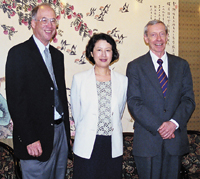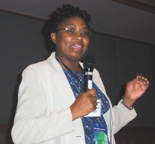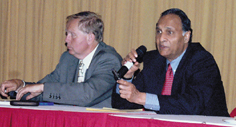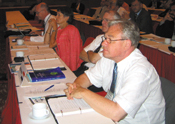|
|
Vol.
27 No. 6
November-December 2005
IUPAC in Beijing—A Wrap Up of the General Assembly
See Division Roundups for brief accounts of division and standing committee meetings at the GA. |
IUPAC
held its 43rd
General Assembly in Beijing, China, from 12–21 August
2005. This was the first General Assembly to be held in China,
or in Asia for that matter. At the Council meeting, Prof.
Kazuko Matsumoto of Japan was elected vice president or president
elect for 2006–2007. Upon stepping in as president in
2008, she will become the second president from Japan and
the first woman president since the Union was established
in 1919.
 |
| President Elect Bryan Henry, Vice President Elect Kazuko Matsumoto, and Secretary General David StC. Black. |
Over the 10 days of the GA, 411 registered participants from 52 countries took part in an intense and intricate schedule of various committee and division meetings and events. Among the highlights of the gathering were a compelling World Chemistry Leadership Meeting that focused on “Chemistry in Asia,” a joint meeting of three committees to discuss IUPAC’s role in furthering public understanding of chemistry, and an inspiring Safety Training Workshop featuring presentations by recent trainees.
At the Welcome Reception, on Saturday 13 August, IUPAC President Leiv Sydnes made his address on the state of the Union. The text of his address is available on the IUPAC Web site at <www.iupac.org/news/archives/2005/p_report_sydnes.html>. Following the address, IUPAC Secretary General David StC. Black introduced the recipients of the 2004 and 2005 IUPAC Prizes for Young Chemists and presented service recognition awards to the retiring division past presidents, division presidents, and standing committee chairmen. The president also awarded the 2005 IUPAC-Samsung Education Prize to Prof. Pavel Kratochvíl on behalf of the Postgrad-uate Course in Polymer Science at the Institute of Macromolecular Chemistry of the Academy of Sciences of the Czech Republic (see article in IUPAC Wire—page 17 in print).
|
| Service recognition awards were presented to retiring division past presidents, division presidents, and standing committee chairmen (from left): Robert Stepto (Division IV), Anders Kallner (VII), Peter Atkins (CCE), David Moore (V), Werner Klein (VI), Piet Steyn (IUPAC Past President), Gerd Rosenblatt (II), Kip Powell (V) , and Ron Weir (I). |
This year, Young Observers again participated in sessions of the GA. Following the same model used in 2003, IUPAC and the Canadian, USA, and UK National Adhering Organizations selected 24 chemists, with varied backgrounds and interests, from 9 countries: Brazil, Canada, Chile, France, India, Russia, Turkey, UK, and the USA. Their participation added vitality and a valuable perspective to the committee work in which they participated. In the past, several young observers have become directly involved in IUPAC.
Most of the GA was devoted to division and standing committee meetings, each of which spanned two days. Division Roundups (in print on page 7, part II will appear in the next CI issue) give brief accounts of these meetings.
On Tuesday 16 August, a joint meeting was held by the Committee on Chemistry Education (CCE), Committee on Chemistry and Industry (COCI), and the CHEMRAWN Committee to discuss public understanding of chemistry. The centerpiece of the three-hour meeting was the presentation of a preliminary report by Peter Mahaffy and his team on “Chemists and the Public: IUPAC’s Role in Achieving Mutual Understanding.” Mahaffy’s forceful presentation—which focused on the constructive and destructive interactions between the general public and IUPAC’s public—generated a great deal of discussion among the more than 50 people in attendance. As he explained, the purpose of the project was to ask where we got it right and what needs improvement. A more detailed article on this report and presentation will appear in a future issue of CI.
 |
| Jane Nyakang’o of the UNIDO National Cleaner Production Centre in Nairobi, Kenya, giving a presentation at the Safety Training Program Workshop. |
A stellar example of IUPAC’s far-reaching impact was a workshop—held Wednesday 17 August and organized by COCI—that brought together eight recent fellows of the Training Program for Safety and Environmental Protection to share their experiences and plans. Through this IUPAC activity, operated jointly with UNESCO and UNIDO, individuals responsible for safety and environmental protection in chemical plant operations and research facilities in developing countries are given free training at a major chemical facility. The fellows—who came from Egypt, Nigeria, Turkey, Kenya, and Uruguay—relayed inspiring stories of how they used their training to create safety programs in environments where safety is often a secondary consideration at best.
 |
| IUPAC President Leiv Sydnes (left) listens as Goverdhan Mehta answers questions after his talk at the World Chemistry Leadership Meeting. |
An important part of every GA is the World Chemistry Leadership Meeting, which brings together national and regional leaders from chemical societies, chemical industry federations, and other organizations to discuss current issues in chemistry that may have a potential international impact. The WCLMs are intended to provide a stimulus for future IUPAC involvement in issues where the Union is in a unique position to provide support to the chemical community. The focal point of the meeting was a well-received talk on “Chemistry in Asia” by Prof. Goverdhan Mehta of the Indian Institute of Science, Bangalore, India. Mehta’s presentation, which gave a kick-start to a wide-ranging discussion, focused on the challenges and opportunities for chemistry in the century ahead. Among the issues he discussed were the strong interest in chemistry in Asia, the pivotal role for chemistry in sustainable development, environmental concerns related to chemical industry, Asia’s growing share of chemical trade, and the surging growth in chemistry research in Asia.
The last two days of the GA, 20 and 21 August, were set aside for the Council meeting. One function of the Council is to elect the officers and members of the Bureau. As noted above, the Council elected Kazuko Matsumoto as vice president. A full professor at Waseda University in Tokyo since 1989, Matsumoto will become president in 2008. Within IUPAC, she has been a titular member on the Analytical Chemistry Division (2002–2005). In Japan, she is a member of the chemistry division of the Science Council of Japan, the Engineering Academy of Japan, and the Council for Science and Technology Policy, cabinet office.
The Council also elected the following individuals to be members of the Bureau for the 2006–2009 term: Chunli Bai (China, reelected), Srinivasan Chandrasekaran (India, reelected), Stanislaw Penczek (Poland), Elsa Reichmanis (USA), Alan Smith (UK, reelected), and Maria van Dam-Mieras (The Netherlands). The following elected members of the Bureau were appointed to the Executive Committee: Chunli Bai (China), Nicole Moreau (France), and Oleg Nefedov (Russia).
 |
| The Dutch delegation at the Council meeting. |
The Council rejected a proposal to begin the process of revising the statutes and bylaws to enable the eventual replacement of the Bureau and Executive Committees with an Executive Board. A number of delegations voiced strong opposition to the measure, primarily because they felt it would disenfranchise the division presidents. In light of the outcome, Vice President Henry announced his intention to create an ad hoc committee to revise the Bylaws and a second committee to examine ways to improve the operational efficiency of IUPAC governance.
In other matters, Council approved National Adhering Organization status for the Caribbean Academy of Sciences–Jamaica Chapter, Jordanian Chemical Society, National Academy of Sciences of Ukraine, and the National Academy of Sciences of Belarus. Council approved the suspension of NAO status for those NAOs who have not paid their 2003 and earlier National Subscriptions by 31 December 2005, until such time as the 2003 and earlier National Subscriptions are paid.
Council also approved the Standing Order and Membership of the Editorial Advisory Board of Pure and Applied Chemistry. The Bureau proposed and the Council approved a motion that the official language of IUPAC continue to be English. The final act of the Council was to approve the proposal from the Royal Society of Chemistry to hold the 2009 Congress and General Assembly in Glasgow, Scotland.
An
interesting diversion at the GA was an exhibit called “The
Project Place,” which illustrated how IUPAC takes a
leadership role in addressing global issues involving every
aspect of chemistry. Attendees were able to sample the flavor
of IUPAC activities displayed in 40 posters set up on level
2 of the convention center. The exhibit demonstrated how most
of the work IUPAC does is channeled through the project system,
which utilizes expert volunteers all over the world. If you
missed the display in Beijing, it is now online at <www.iupac.org/symposia/conferences/ga05/posters.html>
and each poster is also accessible from its corresponding
project page.
The
Project Place was situated so that attendees of the 40th IUPAC
Congress could browse the exhibit. Held concurrently from
August 14–19, the World Chemistry Congress was organized
around the theme “Innovation in Chemistry.” The
Congress, organized by the Chinese Chemical Society and the
Institute of Chemistry of the Chinese Academy of Sciences,
was held in the same building as the GA, which allowed GA
participants to also attend sessions of the Congress. The
Congress itself attracted approximately 1 100 attendees from
around the world, with large representations from China and
other Asian countries.
>
Greetings
from Beijing
- photo page
Page
last modified 2 November 2005.
Copyright © 2003-2005 International Union of Pure and
Applied Chemistry.
Questions regarding the website, please contact [email protected]
|